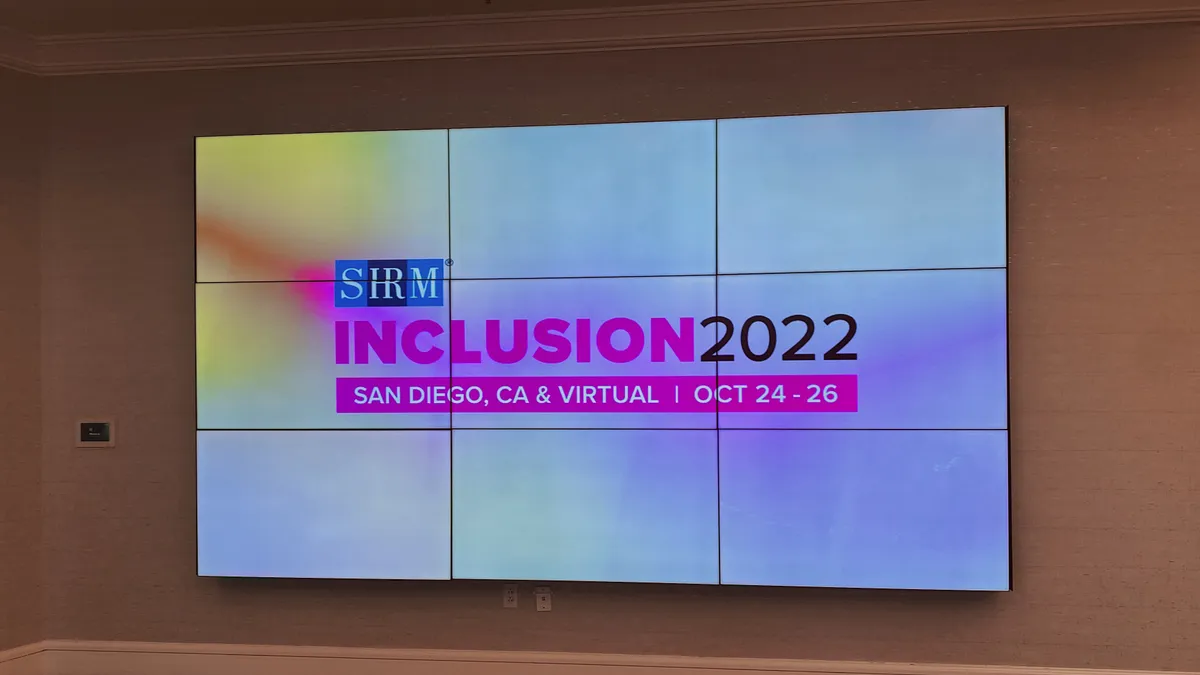Meisha-ann Martin is the director of people analytics at Workhuman. Meisha-ann has a Ph.D. in industrial/organization psychology with fifteen years of experience working in people analytics and employee engagement across a variety of industries. Views are the author's own.
I’m known for my words. It’s not often I struggle with what to say. My mother loves to tell people that I wrote my first novel at age seven. And now, here I am struggling to form words. This topic of diversity, equity and inclusion is deeply personal and requires a level of vulnerability that I find terrifying. Thanks to COVID-19, I have an Afrocentric hairstyle now. That complicates things for me. What if I come across as militant and angry? What will that do for my personal brand and my career? What’s that? Your hair isn’t a potential political statement? Consider yourself privileged.
Somehow, for reasons I do not understand, the George Floyd murder last year was received differently. There were several sparks (and by sparks, I mean deaths) that lit up our world before Floyd’s murder, but for some reason his death caught the eyes of a nation. Personally, I could not bring myself to watch someone die. My soul was already tired. I had already locked myself in a chat room and cried all day after Eric Garner said he couldn’t breathe. And he died six years before Floyd. My adopted nation did not seem to care. I was devastated. And although that feeling dulled somewhat over time, it stayed with me.
However, the video of Floyd’s murder touched the soul of a nation and lit a spark that started a global fire. Our country protested, our CEOs posted videos and sent company-wide letters about the commitment to a better America for all. Many town halls were had. Black folks held their breath. Afraid to hope. We started wondering if this was just all performative or something White folks were doing to check a box and make themselves feel better — like they did something. And yet, these conversations were enlightening. Uncomfortable. Long overdue. Difficult but needed. Important things often are.
2020 has opened a door to a new possibility for diversity, equity and inclusion (DEI) in corporate America. How do we now allow all others to finally walk inside? What is the plan for moving beyond this promising beginning? We don’t want DEI to be a moment; we need it to be a movement. Below is a practical plan for making that happen. I said we were holding our breath. We want to exhale. We would love to breathe.
1. Find your Baseline
You cannot address something if you are not aware of it. I have often heard leaders in organizations talk about fear of engaging in this type of discovery because then the information is "discoverable." Being afraid to know is an insult to people who are afraid to or struggle to show up enthusiastically in an environment that does not feel inclusive. Make the commitment and effort to find out how your organization is doing with key DEI metrics and then fix the identified issues.
Consider this a diversity audit and treat it with all the precision and thoroughness that an audit deserves. Think through every single one of your talent processes and functions. Where could bias and inequity hide? Hunt it out to drive it out. You will want to take a comprehensive review and continue to improve your awareness and understanding over time, but the areas below should get you started on the right path.
Recruitment: Are different types of people attracted to your organization? Who is applying? Does your brand resonate with different types of people? Go beyond "diverse" stock photos and try to form a genuine understanding. Maybe do focus groups at a historically Black college or university. Set up a recruiting table at a local Pride event. Get out there and talk to people. Take advantage of local chapters of organizations like National Society of Black Engineers and National Black MBA Association. Attend a meeting. Volunteer to speak. Find out what different people think about your employer brand. Consider revisiting the diversity statement on your applicant tracking system; try to make it as compelling as possible so that you can actually collect diversity data from the majority of your applicants. Measure and track the percentage of candidates who opt out of providing this data and actively try to increase that number by tweaking the page and the statement.
Selection. Who is referred to your organization? What percentage of new hires are referrals? Are your referrals diverse? If not, maybe ask your employee resource groups (ERGs) to help. If you don't have ERGs, try talking with a diverse sampling of your workforce. Consider actively asking and encouraging your diverse population to refer people from their networks. Take a hard look at your process for selecting new hires. Break it down into steps and look at pass rates by race and gender to make sure women and minorities are equally as likely to get past your resume review, interviews and pre-hire assessments. Many companies have implemented policies requiring a diverse slate of candidates for senior positions. This sounds fantastic but talented women of color often report that they get brought in repeatedly, only to never land the role. If you choose to implement such a policy, monitor pass rates carefully to make sure this doesn’t happen. And make sure interviewers are diverse too, if possible.
Onboarding and orientation. Look at the breadth and strength of new-hire networks and the extent to which individuals feel seen and valued for their differences early on. Ideally, there will be no differences in the strength of relationships, the breadth of networks, the time it takes people to get up to speed or the extent to which people feel seen and valued, even if they see themselves as unique or different.
Engagement. Are different groups equally engaged? If your engagement survey asks about intent to stay or leave, look at the scores on that question for different groups as well. Look at other questions in the survey. Research suggests that minorities may not receive the same quantity or quality of feedback. Based on your survey data, is that happening in your organization? Look at other questions: Maybe the organization’s vision for the future is appealing to some, but not to others. Do you have inclusion, uniqueness and belonging questions in your survey? Consider adding these questions if not. Ideally, all employees should feel a sense of community with their colleagues because they feel like the organization sees and values their authentic selves, that they belong and are included.
Internal mobility. Everyone has the right to grow. See whether promotion rates in your organization reflect this or if representation is only at the lower levels. Examine your executive team: I often see diverse worker bees and far less diversity in leadership positions. Your employees see it. Your applicants see it when they go to the leadership page of your website. If this description applies to your organization and you find that promotion rates are different for different groups, examine your performance, succession and high potential processes.
Performance, succession, potential. Check that performance ratings are relatively equal across groups and at each level. If you have goal ratings and competency ratings, look at each one separately. Competency ratings in particular can be a clue that there is some implicit bias happening in the way different types of people are viewed in an organization. Also look at high potential and successor pools for representation. If your population is representative at lower levels and becomes less so at higher levels based on exits and lack of promotions, bias in the process for identifying high-potential employees and successors may be to blame. If you have recognition data, this is a great place to look for implicit bias and hidden talent. Everyone has the right to be appreciated. There should be no differences in how often different groups are being recognized, monetary values awarded for those efforts and the reasons for recognition.
Salary. Everyone has the right to be paid fairly. Conduct frequent and thorough pay equity review and consider hiring a trusted partner to help with this process. A good partner comes with years of experience and knows how to incorporate different factors like location, tenure, job type and more into their analyses. Consider increasing transparency around pay and promotion practices so all individuals will be equally empowered to manage their careers. If you have not already done so, stop asking new hires for their previous salaries; pay people what the job is worth, regardless of what they earned before. This can also be applied to internal hires. Many organizations limit the salary increase an employee can get with a promotion or job change. It is time we kill that policy. For groups that have been traditionally disadvantaged, it just exacerbates the issue. Furthermore, for people who have been in the organization the longest and are still underpaid, this practice will likely drive them to seek employment elsewhere.
Retention and exit. Examine turnover rates for different groups at different levels. Make sure you don’t have a "leaky bucket" situation happening. Do you start out with great representation but end up losing women and minorities to turnover? Are different types of people equally likely to stay past a year? Does this hold true at every level? Examine your exit surveys, engagement surveys and exit interviews to dig deeper. Examine your turnover reason codes. If you find disproportionately high turnover rates for women and people of color and the reason is usually coded as "personal," you may need more data to understand why. Consider internal focus groups led by an external party to get to the root of what may be causing certain groups to leave at disproportionate rates. Look at new hire rates specifically.
2. Make a plan
Your measure step should have provided great insights on your areas of most opportunity. In the next stage, you may find the following strategies helpful.
Choose an executive sponsor and assemble a diverse task force. This means going beyond human resources; an ideal executive sponsor would be a business unit leader who is passionate about diversity. Bonus points for White males. A White male sponsor sends a signal that allies have a place in the movement and a visible ally can help educate and recruit other ally champions. Please do not tap your most senior female or person of color on the shoulder and make them take this role. We need to stop making the victims of inequity responsible for leading the effort to fix the issues. Allow them to volunteer if they wish, but please ensure they are not "voluntold." If your organization has ERGs, pull together the leaders of each of the groups to function as a task force. The task force should have full visibility into the results of the first step and should be empowered to contribute ideas.
Prioritize accountability. Although the task force is important for vetting and providing ideas, try to avoid diffusion of responsibility. Assign a clear owner of the effort. A chief diversity officer is the perfect person. Or, in the absence of such a role, divide the plan into parts and assign individual owners to each part of the plan.
Consider timing. When thinking about the results of the first step, try to find things you can do quickly. Ideally, you will be able to demonstrate your commitment with a series of visible actions that start right away and continue the forward momentum. With this in mind, make sure your plan includes immediate and longer-term action items.
3. Commit publicly and specifically to employees and community
Many of your employees are not quite sure about your commitment to diversity. With all the town halls, listening sessions and CEO letters after Floyd’s murder, your employees are waiting to see what you do next. Be transparent and communicate actions even if those actions are not yet outcomes. Among other things:
-
Introduce this measure; plan, commit and measure again; adopt a framework.
-
Communicate often about exactly where you are in the process and the next steps.
-
Share opportunities and plans of action and ask for feedback.
-
Regularly listen to various stakeholders to hear how the work and outcomes are experienced and perceived.
If you communicated to the public previously about your commitment to diversity, you should also be communicating your follow-up actions. Consider including a statement or video outlining your plan as part of your career page. Release at least your workforce representation numbers like LinkedIn, Merck, Accenture and P&G do. This vulnerability and authenticity will speak volumes to your employees. There are additional advantages as well. It will attract people who are looking for a safe and inclusive workplace. It also will attract investors and consumers looking for companies that align with their personal DEI values. These actions will make DEI part of your employment brand and will invite employees and others to hold you accountable to your commitment.
4. Measure progress and communicate wins and failures
This step should occur in parallel with steps 2 and 3. Once you decide how best to address your areas of opportunity, decide how you will measure progress and include that when you share the action plan. Communicate successes and failures. Be vulnerable and humble. Ask your people to help you as you embark on this journey. Continually ask your employees for feedback and provide them with the safe space to provide it. Additionally, a DEI certification can illustrate progress and communicate a commitment.
As you get further along in this journey, you also will want to think through how to hold leaders accountable: Consider unintended consequences and ensure your plan for accountability leads to the desired behaviors. A diverse, cross-functional task force can help you think through this.
Do these ideas make you uncomfortable? Are you a little scared and sweaty? Sit with that for a minute. Your momentary discomfort is a small price to pay for removing the more permanent and pervasive levels of discomfort that some people feel in organizations every day. Your discomfort is a sign that you are primed to do important and revolutionary work. I look forward to it.





















